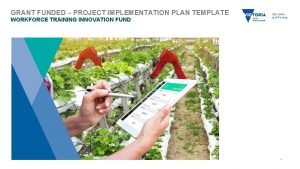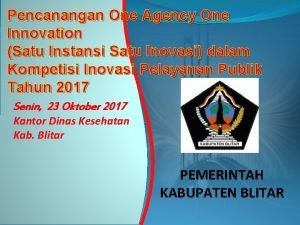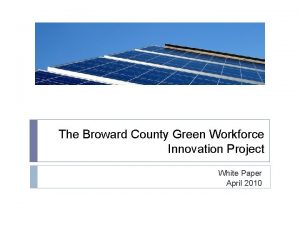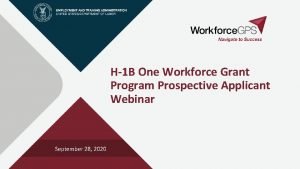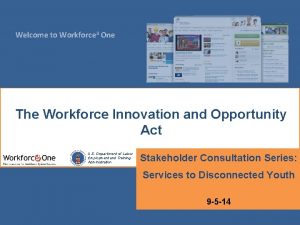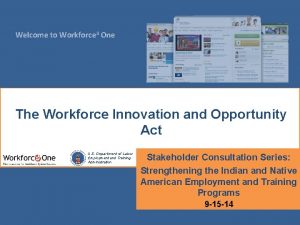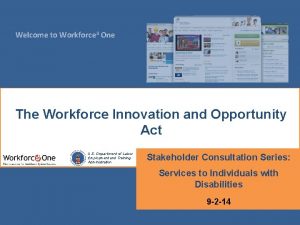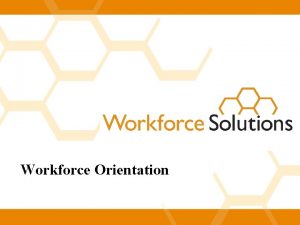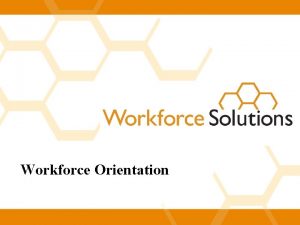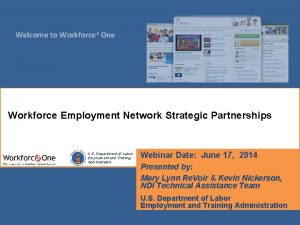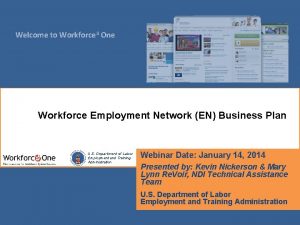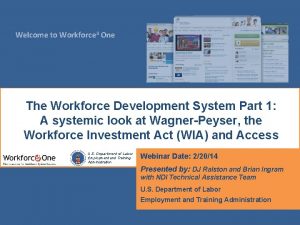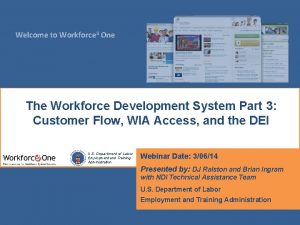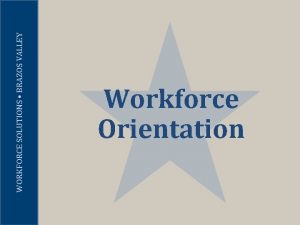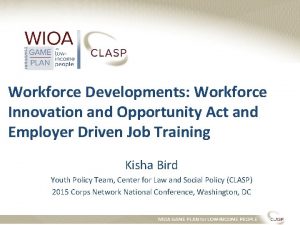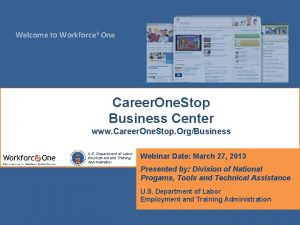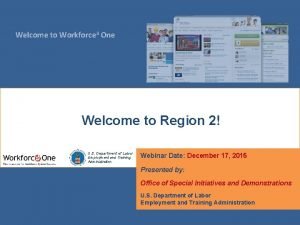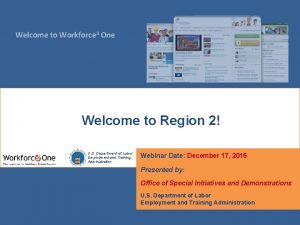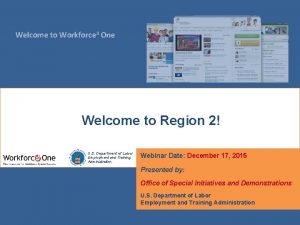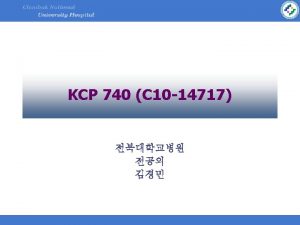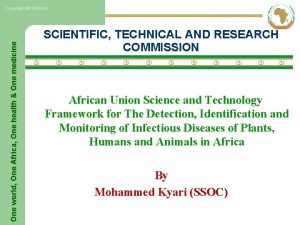Welcome to Workforce 3 One The Workforce Innovation



























- Slides: 27

Welcome to Workforce 3 One The Workforce Innovation and Opportunity Act U. S. Department of Labor Employment and Training Administration Stakeholder Consultation Series: Job-Driven Training for Adults and Dislocated Workers 8 -22 -14

Agenda § Purpose and Session Flow § Overview of the Workforce Innovation and Opportunity Act (WIOA) § Key Provisions Related to Job-Driven Training for Adults and Dislocated Workers Discussion Questions § Technical Assistance Tools and Resources § Stakeholder Engagement – Webinar Series Schedule 2

Purpose This series of stakeholder consultation webinars is aimed to: § Gather input from state and local workforce leaders and practitioners, workforce system partners, customers, and other stakeholders on key implementation topics; § Inform development of regulations; and § Inform technical assistance strategies to support implementation. Please note that ETA is also planning to conduct a series of Town Halls this Fall to gather input from the field, and that you are always welcome to send comments and questions to DOL. WIOA@dol. gov Our Federal Partners (ED and HHS) are also collecting input, and we are working closely together on implementing the new legislation. 3

Session Flow § The Department of Labor is in a “listening” mode. § Submit your responses and input to the discussion questions through the chat feature. § Responses will be reviewed analyzed as we are developing draft regulations and planning future guidance issuance and technical assistance. 4

Opening Remarks Mark Mitsui Deputy Assistant Secretary for Community Colleges Office of Career, Technical and Adult Education US Department of Education 5

Overview of the Workforce Innovation and Opportunity Act § President Barack Obama signed WIOA into law on July 22, 2014. § Passed by Congress with wide bipartisan majority (The Senate voted 935 and the House of Representatives voted 415 -6). § Reaffirms ongoing role of American Job Centers. § Promotes program coordination and alignment of key employment, education, and training programs at the Federal, State, local, and regional levels. § Builds on proven practices such as sector strategies, career pathways, regional economic approaches, work-based training. § Complements and supports the President’s Job-Driven Workforce Vision. 6

Programs under the Workforce Innovation and Opportunity Act § Supersedes the Workforce Investment Act of 1998 and retains and amends the Adult Education and Family Literacy Act, the Wagner-Peyser Act, and the Rehabilitation Act of 1973. § Identifies “core programs”: – Adults, Dislocated Workers, and Youth formula programs and Wagner. Peyser employment services administered by the Department of Labor; and – Adult education and literacy programs and Vocational Rehabilitation state grant programs that assist individuals with disabilities in obtaining employment administered by the Department of Education. § Authorizes the Job Corps, Youth. Build, Indian and Native Americans, and Migrant and Seasonal Farmworker programs, and evaluation and research activities conducted by DOL. 7

Highlights of Reforms to the Public Workforce Systemunder the Act § Requires states to strategically align workforce development programs to support job seekers and employers. § Promotes accountability and transparency of programs. § Fosters regional collaboration to meet the needs of regional economies. § Streamlines and strengthens the strategic roles of workforce development boards. § Enhances services provided to job seekers and employers through the American Job Center system. § Improves services to employers and promotes work-based training. 8

Highlights of Reforms to the Public Workforce Systemunder the Act § Provides access to high quality training § Enhances workforce services for the unemployed and other job seekers. § Improves services to individuals with disabilities. § Makes key investments in serving disconnected youth and other vulnerable populations, including Native Americans and Migrant and Seasonal Farmworkers. § Increases the performance and quality of the Job Corps program. § Reinforces connections with Registered Apprenticeship. 9

Job-Driven Training In July 2014, Vice President Biden issued a report titled “Ready to Work: Job-Driven Training and American Opportunity” and developed the Job-Driven Checklist is built off of the work being done every day at American Job Centers Nationwide Job-Driven Training Involves 3 Important Themes ◦ Business Engagement ◦ Strong Data ◦ Stakeholder Collaboration 10

Job-Driven Checklist 1. Work with business to determine local or regional hiring needs and to inform the of design training programs. 2. Utilize work-based learning opportunities 3. Use of data to drive accountability and better inform jobseekers 4. Measure and evaluate employment and earnings 5. Promote seamless progression from education and training programs 6. Help jobseekers address barriers to accessing job-driven training 7. Promote regional collaboration among AJCs, education institutions, labor, and nonprofits 11

Kick-Off Question What are your top three priorities for implementation of WIOA? 12

Workforce Innovation and Opportunity Act Provisions Related to Job-Driven Training Ø Training that leads to industry recognized post-secondary credentials is emphasized. Ø States and local areas will use career pathways to provide education and employment and training assistance to accelerate job seekers’ educational and career advancement. Ø Local areas can use funds for demonstrated strategies including incumbent worker training, Registered Apprenticeship, transitional jobs, on-the-job training, and customized training. Ø Increased reimbursement rates for on-the-job and customized training. 13

Workforce Innovation and Opportunity Act Provisions Related to Job-Driven Training Ø Local areas have additional procurement vehicles for training to increase customer choice and quality, including individual training accounts, pay for performance contracts, and direct contracts with higher education. Ø WIA service categories of core and intensive services are collapsed into “career services” and there is no required sequence of services, enabling job seekers to access training immediately. Ø Local areas have flexibility to serve job seekers with greatest need by transferring up to 100 percent of funds between the Adult and Dislocated Worker programs. Ø Registered Apprenticeship programs are included on the eligible training provider list. 14

Discussion Questions- 1 A key component of both the Job-Driven Agenda and the Workforce Innovation and Opportunity Act (WIOA) is employer engagement and satisfaction. Ø Under WIA, have you developed any promising practices for collecting this information and have you developed any mechanisms to gauge if training provided aligns with the employer’s needs? Also, are there any common challenges that should be considered in developing guidance? 15

Discussion Questions- 2 WIOA collapses intensive and core services into the single category of “career services. ” ØUnder WIA, did the separate categories of “core” and “intensive” services create any barriers or challenges and are there any potential challenges or benefits with the new combined “career services”? Also, will this change have an impact on how services are provided? 16

Discussion Questions- 3 WIOA and the Job Driven Agenda strongly emphasize work-based learning models including OJT, Registered Apprenticeship, and transitional jobs. Ø OJT contracts often are perceived as overly complicated and challenging to develop. What has been your experience and have you identified any promising practices that have facilitated the implementation of work-based learning? Also, have you experienced any other challenges with OJT or other work-based learning strategies, such as transitional jobs, paid internships, or Registered Apprenticeships? 17

Discussion Question -4 WIOA provides additional procurement vehicles for training, including pay for performance contracts, customized training, and direct contracts with higher education. These additional flexibilities are intended to provide greater access to training, which aligns with the job-driven vision. Ø Do you have any previous exposure to or experience with these procurement approaches and do you foresee any challenges with their implementation? 18

Discussion Question- 5 WIOA provides authority for local boards to transfer 100 percent of funds between the Adult and Dislocated Worker programs. Ø What are some of the potential advantages and disadvantages of the increased transfer authority? 19

Discussion Questions- 6 WIOA and the job-driven vision both emphasize the importance of high quality training. To help ensure the quality of training, WIOA has strengthened eligible training provider requirements, such as performance reporting for all participants in the program of study and costs associated with such training. ØWhat are potential implementation challenges associated with these changes and where is technical assistance most needed? 20

Discussion Questions- 7 WIOA significantly broadens allowable statewide activities to include: sectorial and industry cluster strategies and partnerships; career pathway programs; microenterprise and entrepreneurial training; use of direct and prior learning assessments to provide credit for experience; development of common intake procedures; and several other strategies that help to align activities. Ø To what degree are these activities already taking place and where is technical assistance and/or guidance most needed? 21

Discussion Questions- 8 ØWhat other changes to adult and/or dislocated worker service delivery does WIOA introduce that create new opportunities or challenges? 22

Discussion Questions- 9 ØWhat challenges at the federal or state level should DOL consider in developing guidance? 23

Discussion Questions- 10 ØIs there anything else you want us to share with us today? 24

Technical Assistance Tools and Resources § Department of Labor – WIOA Resource Page (www. doleta. gov/WIOA) – WIOA Dedicated Email (DOL. WIOA@dol. gov) § Department of Education – Office of Career, Technical, and Adult Education’s WIOA Resource Page (http: //www. ed. gov/AEFLA) – Rehabilitation Services Administration’s WIOA Resource Page (http: //www 2. ed. gov/about/offices/list/osers/rsa/wioareauthorization. html) 25

Stakeholder Engagement INFORMATION ON CURRENT AND FUTURE OPPORTUNITIES TO PROVIDE INPUT IS BE AVAILABLE AT WWW. DOLETA. GOV/WIOA. August 8/25 - Integrated Performance Reporting and the ETPL 8/26 - Consultation with Consumers, Advocacy Groups, and Direct Service Providers on Services for Individuals with Disabilities 8/28 - The Migrant and Seasonal Farmworker Program September 9/2 - Services to Individuals with Disabilities 9/5 - Services to Disconnected Youth 9/11 - Strategic Program Alignment and Unified Planning 9/12 - WIOA and Registered Apprenticeship 9/15 -The Indian and Native American Program 26

Thank You! Find resources for workforce system success at: www. workforce 3 one. org 27
 Project implementation plan templates
Project implementation plan templates Workforce innovation fund
Workforce innovation fund One agency one innovation
One agency one innovation Mysite socccd
Mysite socccd Disruptive and radical innovation
Disruptive and radical innovation Wise men three clever are we
Wise men three clever are we White green program
White green program One workforce grant
One workforce grant One empire one god one emperor
One empire one god one emperor One one one little puppy run
One one one little puppy run One king one law one faith
One king one law one faith One empire one god one emperor
One empire one god one emperor One ford behaviors
One ford behaviors See one do one teach one
See one do one teach one One price policy
One price policy Structure of twelfth night
Structure of twelfth night See one do one teach one
See one do one teach one One vision one identity one community
One vision one identity one community One vision one identity one community
One vision one identity one community Hát kết hợp bộ gõ cơ thể
Hát kết hợp bộ gõ cơ thể Slidetodoc
Slidetodoc Bổ thể
Bổ thể Tỉ lệ cơ thể trẻ em
Tỉ lệ cơ thể trẻ em Gấu đi như thế nào
Gấu đi như thế nào Tư thế worm breton là gì
Tư thế worm breton là gì Alleluia hat len nguoi oi
Alleluia hat len nguoi oi Môn thể thao bắt đầu bằng từ đua
Môn thể thao bắt đầu bằng từ đua Thế nào là hệ số cao nhất
Thế nào là hệ số cao nhất
